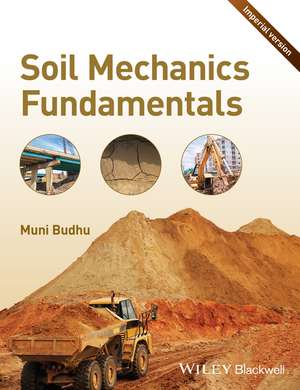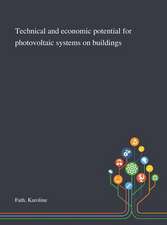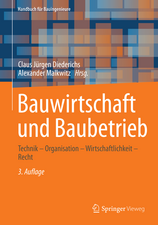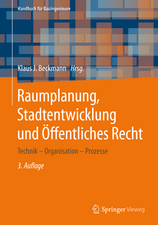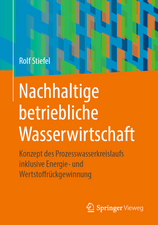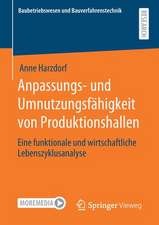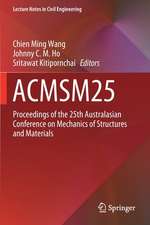Soil Mechanics Fundamentals Imperial
Autor M Budhuen Limba Engleză Paperback – 13 aug 2015
Soil Mechanics Fundamentals lays a solid foundation on key principles of soil mechanics for application in later engineering courses as well as in engineering practice. With this textbook, students will learn how to conduct a site investigation, acquire an understanding of the physical and mechanical properties of soils and methods of determining them, and apply the knowledge gained to analyse and design earthworks, simple foundations, retaining walls and slopes.
The author discusses and demonstrates contemporary ideas and methods of interpreting the physical and mechanical properties of soils for both fundamental knowledge and for practical applications.
The chapter presentation and content is informed by modern theories of how students learn:
- Learning objectives inform students what knowledge and skills they are expected to gain from the chapter.
- Definitions of Key Terms are given which students may not have encountered previously, or may have been understood in a different context.
- Key Point summaries throughout emphasize the most important points in the material just read.
- Practical Examples give students an opportunity to see how the prior and current principles are integrated to solve 'real world' problems.
Preț: 547.44 lei
Preț vechi: 710.97 lei
-23% Nou
Puncte Express: 821
Preț estimativ în valută:
104.77€ • 108.97$ • 86.49£
104.77€ • 108.97$ • 86.49£
Carte tipărită la comandă
Livrare economică 12-26 aprilie
Preluare comenzi: 021 569.72.76
Specificații
ISBN-13: 9780470577950
ISBN-10: 0470577959
Pagini: 370
Dimensiuni: 191 x 247 x 33 mm
Greutate: 0.82 kg
Ediția:New.
Editura: Wiley
Locul publicării:Chichester, United Kingdom
ISBN-10: 0470577959
Pagini: 370
Dimensiuni: 191 x 247 x 33 mm
Greutate: 0.82 kg
Ediția:New.
Editura: Wiley
Locul publicării:Chichester, United Kingdom
Public țintă
- Undergraduate students of civil engineering (every civil engineering student has to study soil mechanics as a core part of their syllabus)
- Soil mechanics and geotechnical engineering are also studied by students of construction, mining and geological engineering, and environmental engineering
Cuprins
About the Author xi Other Books by this Author xiii Preface xv Acknowledgments xix Notes for Students and Instructors xxi Notation, Abbreviations, Unit Notation, and Conversion Factors xxv 1 Composition and Particle Sizes of Soils 1 1.1 Introduction 1 1.2 Definitions of Key Terms 1 1.3 Composition of Soils 2 1.3.1 Soil formation 2 1.3.2 Soil types 2 1.3.3 Soil minerals 3 1.3.4 Surface forces and adsorbed water 5 1.3.5 Soil fabric 6 1.4 Determination of Particle Size 7 1.4.1 Particle size of coarse-grained soils 7 1.4.2 Particle size of fine-grained soils 9 1.5 Characterization of Soils Based on Particle Size 10 1.6 Comparison of Coarse-Grained and Fine-Grained Soils for Engineering Use 18 1.7 Summary 19 Exercises 19 2 Phase Relationships, Physical Soil States, and Soil Classification 23 2.1 Introduction 23 2.2 Definitions of Key Terms 23 2.3 Phase Relationships 24 2.4 Physical States and Index Parameters of Fine-Grained Soils 36 2.5 Determination of the Liquid, Plastic, and Shrinkage Limits 40 2.5.1 Casagrande's cup method: ASTM D 4318 40 2.5.2 Plastic limit test: ASTM D 4318 41 2.5.3 Shrinkage limit: ASTM D 427 and D 4943 42 2.6 Soil Classification Schemes 45 2.6.1 American Society for Testing and Materials and the Unified Soil Classification System (ASTM-USCS) 45 2.6.2 AASHTO soil classification system 45 2.6.3 Plasticity chart 49 2.7 Engineering Use Chart 50 2.8 Summary 54 2.8.1 Practical examples 54 Exercises 57 3 Soils Investigation 63 3.1 Introduction 63 3.2 Definitions of Key Terms 64 3.3 Purposes of a Soils Investigation 64 3.4 Phases of a Soils Investigation 65 3.5 Soils Exploration Program 66 3.5.1 Soils exploration methods 67 3.5.1.1 Geophysical methods 67 3.5.1.2 Destructive methods 71 3.5.2 Soil identification in the field 72 3.5.3 Number and depths of boreholes 75 3.5.4 Soil sampling 76 3.5.5 Groundwater conditions 78 3.5.6 Types of in situ or field tests 79 3.5.6.1 Vane shear test (VST): ASTM D 2573 80 3.5.6.2 Standard penetration test (SPT): ASTM D 1586 81 3.5.6.3 Cone penetrometer test (CPT): ASTM D 5778 87 3.5.6.4 Pressuremeter: ASTM D 4719-87 90 3.5.6.5 Flat plate dilatometer (DMT) 90 3.5.7 Soils laboratory tests 92 3.5.8 Types of laboratory tests 92 3.6 Soils Report 93 3.7 Summary 95 Exercises 96 4 One- and Two-Dimensional Flows of Water Through Soils 99 4.1 Introduction 99 4.2 Definitions of Key Terms 99 4.3 One-Dimensional Flow of Water Through Saturated Soils 100 4.4 Flow of Water Through Unsaturated Soils 103 4.5 Empirical Relationship for kz 103 4.6 Flow Parallel to Soil Layers 105 4.7 Flow Normal to Soil Layers 106 4.8 Equivalent Hydraulic Conductivity 106 4.9 Laboratory Determination of Hydraulic Conductivity 108 4.9.1 Constant-head test 108 4.9.2 Falling-head test 109 4.10 Two-Dimensional Flow of Water Through Soils 112 4.11 Flownet Sketching 114 4.11.1 Criteria for sketching flownets 115 4.11.2 Flownet for isotropic soils 116 4.12 Interpretation of Flownet 116 4.12.1 Flow rate 116 4.12.2 Hydraulic gradient 117 4.12.3 Critical hydraulic gradient 117 4.12.4 Porewater pressure distribution 118 4.12.5 Uplift forces 118 4.13 Summary 119 4.13.1 Practical examples 119 Exercises 123 5 Soil Compaction 127 5.1 Introduction 127 5.2 Definition of Key Terms 127 5.3 Benefits of Soil Compaction 128 5.4 Theoretical Maximum Dry Unit Weight 128 5.5 Proctor Compaction Test: ASTM D 698 and ASTM D 1557 128 5.6 Interpretation of Proctor Test Results 131 5.7 Field Compaction 137 5.8 Compaction Quality Control 139 5.8.1 Sand cone: ASTM D 1556 139 5.8.2 Balloon test: ASTM D 2167 141 5.8.3 Nuclear density meter: ASTM D 2922 and ASTM D 5195 142 5.8.4 Comparisons among the three popular compaction quality control tests 142 5.9 Summary 143 5.9.1 Practical example 143 Exercises 145 6 Stresses from Surface Loads and the Principle of Effective Stress 149 6.1 Introduction 149 6.2 Definition of Key Terms 149 6.3 Vertical Stress Increase in Soils from Surface Loads 150 6.3.1 Regular shaped surface loads on a semi-infinite half-space 150 6.3.2 How to use the charts 155 6.3.3 Infinite loads 156 6.3.4 Vertical stress below arbitrarily shaped areas 157 6.4 Total and Effective Stresses 166 6.4.1 The principle of effective stress 166 6.4.2 Total and effective stresses due to geostatic stress fields 167 6.4.3 Effects of capillarity 168 6.4.4 Effects of seepage 169 6.5 Lateral Earth Pressure at Rest 177 6.6 Field Monitoring of Soil Stresses 178 6.7 Summary 179 6.7.1 Practical example 179 Exercises 181 7 Soil Settlement 187 7.1 Introduction 187 7.2 Definitions of Key Terms 187 7.3 Basic Concept 188 7.4 Settlement of Free-Draining Coarse-Grained Soils 191 7.5 Settlement of Non-Free-Draining Soils 192 7.6 The One-Dimensional Consolidation Test 193 7.6.1 Drainage path 195 7.6.2 Instantaneous load 195 7.6.3 Consolidation under a constant load: primary consolidation 196 7.6.4 Effective stress changes 196 7.6.5 Effects of loading history 198 7.6.6 Effects of soil unit weight or soil density 198 7.6.7 Determination of void ratio at the end of a loading step 200 7.6.8 Determination of compression and recompression indexes 200 7.6.9 Determination of the modulus of volume change 201 7.6.10 Determination of the coefficient of consolidation 202 7.6.10.1 Root time method (square root time method) 203 7.6.10.2 Log time method 204 7.6.11 Determination of the past maximum vertical effective stress 205 7.6.11.1 Casagrande's method 205 7.6.11.2 Brazilian method 206 7.6.11.3 Strain energy method 206 7.6.12 Determination of the secondary compression index 208 7.7 Relationship between Laboratory and Field Consolidation 216 7.8 Calculation of Primary Consolidation Settlement 218 7.8.1 Effects of unloading/reloading of a soil sample taken from the field 218 7.8.2 Primary consolidation settlement of normally consolidated fine-grained soils 219 7.8.3 Primary consolidation settlement of overconsolidated fine-grained soils 219 7.8.4 Procedure to calculate primary consolidation settlement 220 7.9 Secondary Compression 221 7.10 Settlement of Thick Soil Layers 221 7.11 One-Dimensional Consolidation Theory 224 7.12 Typical Values of Consolidation Settlement Parameters and Empirical Relationships 226 7.13 Monitoring Soil Settlement 227 7.14 Summary 228 7.14.1 Practical example 228 Exercises 232 8 Soil Strength 239 8.1 Introduction 239 8.2 Definitions of Key Terms 239 8.3 Basic Concept 240 8.4 Typical Response of Soils to Shearing Forces 240 8.4.1 Effects of increasing the normal effective stress 242 8.4.2 Effects of overconsolidation ratio, relative density, and unit weight ratio 243 8.4.3 Effects of drainage of excess porewater pressure 245 8.4.4 Effects of cohesion 246 8.4.5 Effects of soil tension and saturation 247 8.4.6 Effects of cementation 248 8.5 Three Models for Interpreting the Shear Strength of Soils 249 8.5.1 Coulomb's failure criterion 250 8.5.2 Mohr-Coulomb failure criterion 251 8.5.2.1 Saturated, uncemented soils at critical state (Figure 8.9) 252 8.5.2.2 Saturated, uncemented soils at peak state 252 8.5.2.3 Unsaturated, cemented, cohesive soils (Figure 8.10) 252 8.5.3 Tresca's failure criterion 254 8.6 Factors Affecting the Shear Strength Parameters 256 8.7 Laboratory Tests to Determine Shear Strength Parameters 258 8.7.1 A simple test to determine the critical state friction angle of clean coarse-grained soils 258 8.7.2 Shear box or direct shear test ASTM D 3080 258 8.7.3 Conventional triaxial apparatus 268 8.7.4 Direct simple shear 278 8.8 Specifying Laboratory Strength Tests 279 8.9 Estimating Soil Parameters from in Situ (Field) Tests 280 8.9.1 Vane shear test (VST): ASTM D 2573 280 8.9.2 Standard penetration test (SPT)): ASTM D 1586 281 8.9.3 Cone penetrometer test (CPT): ASTM D 5778 282 8.10 Some Empirical and Theoretical Relationships for Shear Strength Parameters 283 8.11 Summary 284 8.11.1 Practical examples 284 Exercises 290 Appendix A: Derivation of the One-Dimensional Consolidation Theory 295 Appendix B: Mohr's Circle for Finding Stress States 299 Appendix C: Frequently Used Tables of Soil Parameters and Correlations 301 Appendix D: Collection of Equations 313 References 325 Index 329
Notă biografică
Muniram (Muni) Budhu is Professor of Civil Engineering & Engineering Mechanics at the University of Arizona, Tucson, Arizona. He received his BSc (First Class Honors) in Civil Engineering from the University of the West Indies and his PhD in Soil Mechanics from Cambridge University, England. Prior to joining the University of Arizona, Dr. Budhu served on the faculty at the University of Guyana; McMaster University, Canada and the State University of New York at Buffalo. He spent sabbaticals as visiting Professor at St. Catherine's College, Oxford University; Eidgenössische Technische Hochschule Zürich(Swiss Federal Institute of Technology, Zurich), and theUniversity of Western Australia.
